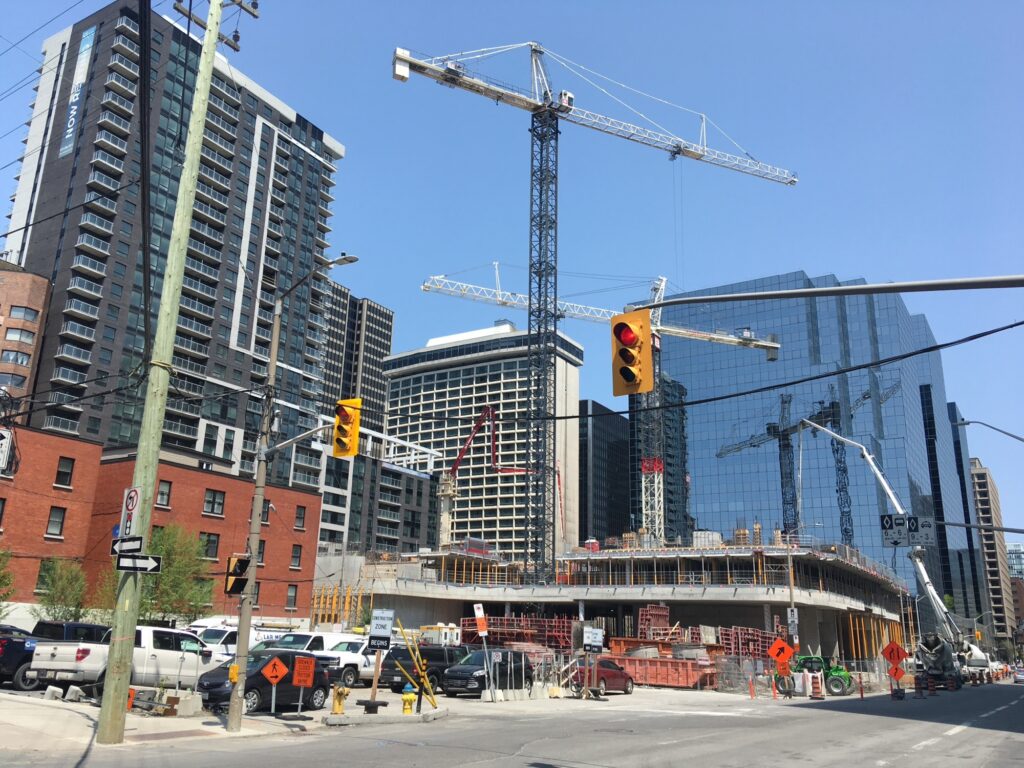Guest post by former Bike Ottawa president Hans “Hans on the Bike” Moor, who attended the conference on behalf of Bike Ottawa.
Late last year, Bike Ottawa attended a conference organised by the Canadian Urban Institute (CUI), with the theme: “the State of Canada’s Cities”. The CUI is a non-profit applied research organization headquartered in Toronto, Ontario, dedicated to building vibrant, equitable, and sustainable cities. Like last year, the conference took place at the National Art Centre on Elgin St. in Ottawa.
Sombre picture
The morning started off on a somewhat sombre note with concerns about the lack of success in attracting foreign investment, the lack of progress in the digital economy, Canada being “ad hoc-ery”, deferred maintenance in civic infrastructure, a chronic lack of data or even access to data, no national infrastructure plan, funding problems due to undercharging and populism such as lowering electricity prices and resisting toll on major roads.
There is concern about inflation not equally spread over the population as price increases in food have a larger effect on poorer households. Food is taking a larger percentage of their income than that of higher income families. Then there is the transfer of infrastructure cost. The municipalities’ share is now 60% and improvements in city infrastructure have become dependent on grants, which are often political. All in all, not a very rosy picture!
E-cars don’t solve congestion
It was suggested that investing billions in e-cars might look good politically but it doesn’t solve congestion in our cities; proper investing in transit on the other hand does allow people to move around faster. Hand in hand with transit investments is more attention for digital infrastructure and Transit Oriented Development (often referred to as TOD). Although this was not mentioned at the conference, Dutch railways invested heavily in cycling storage at train stations in order to accommodate the massive use of bicycles for the ‘last mile’ between stations and home.
Work from home killed downtown
Ottawa’s mayor, Mark Sutcliffe made the point that Ottawa has a large share of federal workers who now work from home part of the time, which has devastating effects on the downtown core. He mentioned the challenges in Ottawa with transit, healthcare, infrastructure, although he neglected to that he campaigned on 0% raise in property taxes, kicking the budget problems down the road. Sarah Rosen Wartell, President, Urban Institute, Washington, DC, mentioned that nowadays the City of Washington, DC sees the biggest traffic going into downtown at 5 PM (!) going to entertainment venues.
Mayor Sutcliffe criticized those who want to freeze Development Charges to create cheaper housing. He believes that doesn’t work as the city needs those funds to build infrastructure. In his words: “You can’t give with one hand, and take with the other”. Sutcliffe finished by mentioning that housing is the biggest priority, and that there is a perception that city administrations are the biggest obstacle, but that in Ottawa’s case the number of approvals is much higher than what is actually being built.
More cooperation
We learned that on average government offices are less than 50% occupied. We in Ottawa know all about it as it has been discussed widely in our city. Affordable housing has priority nationwide now and Canada Lands plays a role in this. Fortunately we heard from one panel that Canada Lands, Canadian Mortgage and Housing Corporation and the Federal Public Services & Procurement Canada are cooperating more to get things done. On the other hand, a representative of a smaller town said they have problems accessing money just because, well, they are a smaller town: smaller amounts are not available.
Quartier des Spectacles
Arts & culture are not doing well and someone mentioned dryly: “could we not have a gym on every block, but an arts centre instead”. Monique Simard from the ‘Partenariat du Quartier des Spectacles’ shared several insights about the successful ‘Spectacle Quarter’ in Montreal, initiated by the city to revive downtown Montreal. It currently hosts 52 events a year, and brings in 3 billion dollars in revenue annually. It is successful in creating partnerships with creators and organisers and it has become the #1 attraction for Montreal. It is funded by the City but it is not a department, allowing for more creative freedom.
Beauty can cross boundaries
Tobi Nussbaum, CEO of the NCC talked about quantifying beauty and gave as an example the renovated Boat House in Rockcliffe and how people are coming from afar to enjoy the structure on the Ottawa River: “Beauty can cross class boundaries”, Nussbaum said. It is important that there are public spaces where you don’t have to buy or consume anything. Such places are really hard to find in Ottawa in winter, and libraries are starting to become those indoor community hubs. I have often wondered where I could meet someone at the Merivale Road or South Keys area without having to buy coffee. An aging mall is the only option if you don’t want to disturb the quiet peace at a library, which isn’t always open anyway.
“Stop planning, start building”
Fanny Tremblay-Racicot, Associate Professor, École nationale d’administration publique, Québec, QC sent everyone home with the message “Stop planning, start building” after she was asked what we could do in the short term. Someone else in the last panel mentioned that decision makers should not have a fear of taking the initiative and “don’t let a fear for liability be in your way”.

“Public sector has to lead again”
Typically for conferences like these, everyone agrees on what the right things to do are, from more money for infrastructure, to building faster and more attractive but also affordable, with fewer restrictions on design. I sensed people want to see a bigger role for cities to build, experiment and show leadership in new building techniques. Jason Thorne, freshly appointed as the new chief planner for Toronto the day he was at the conference, said that the public sector has to lead again. He mentioned specifically the ‘Passiv Haus’ concept, where buildings barely need heating and therefore produce very little to no carbon. The extra cost is surprising low and will be earned back by near zero heating bills.
Age-friendly design
Finally, the suggestion was made to look into age-friendly design, which benefits everyone, as we all become seniors eventually (except cyclists who stay young forever). There is funding available for the public realm and age friendly places as the WHO has produced updated guidelines in 2023. the CUI should be able to tell soon where that money is available.
What’s next?
This conference was very much a thought conference and not much of a ‘look what is happening’ conference. This was not a cycling conference either obviously; in fact, the only person who mentioned cycling was Ottawa Kate Whitfield, recent Co-Founder and Principal of Take Consulting Ltd., who has always been a champion for cycling in the planning field. Yet all the ideas, suggestions and thoughts mentioned during the conference would be favourable to cycling, from Transit Oriented Developments to improvements in data collection to replacing aging infrastructure. As former Bike Ottawa board member Alex de Vries always says, “sewers are the biggest friend of cycling infrastructure” because sewer renewal requires ripping up the roads.
Therefore, I am confident that the trend of investments in cycling, or Active Transportation for that matter, despite local setback will continue. There was clearly an aversion to political meddling in building cities at this conference, but at the same time it is important to be organised and to raise our voices for better cities. The state of the cities generally is not good. Urbanists must continue to press provincial and federal governments to provide more money to cities, partly to catch up with delayed upgrades in infrastructure, from underground works to community buildings and hockey rinks. But also, frankly, partly to lead and inspire instead of becoming bean counters looking for efficiencies.
“Living Capital” report
It is worth reading the “Living Capital” report that was written by the Canadian Urban Institute for the Ottawa Board of Trade that specifically mentions bike share, investments in cycling infrastructure, introducing no right through red, speed humps, better street safety and better transit. You can find the report, released in May 2024 here.

